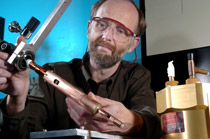Source: EE Times, and tgdaily.

A unique, inexpensive solid-state source of terahertz radiation has been demonstrated by Argonne National Laboratories, working with researchers in Japan and Turkey. Terahertz (THz) frequencies can penetrate clothing, leather, fabric, cardboard, paper and some building materials, but not metal or water. Since they are non-ionizing (unlike x-rays, which can knock your electrons out of orbit, terahertz emitters enable ¡°x-ray vision¡± applications without the health hazards, for everything from security scans to medical and dental imaging.
Unfortunately, industrial deployment of terahertz scanners has been hampered by a lack of an inexpensive solid-state source, because of the ¡°terahertz gap¡± between microwave wavelengths (centimeters) and optical wavelengths (microns). For these millimeter wavelengths in the terahertz gap, there have been no solid-state devices that produced them. Now, this international team claims to have demonstrated that stacks of superconducting Josephson junctions can produce microwatts of power at millimeter wavelengths, with the promise of milliwatts for future battery-operated handheld terahertz scanners.
The team, led by Ulrich Welp, of Argonne¡¯s Materials Science Division (Argonne, Ill.), designed a stack of over 1000 Josephson junctions, each one generating terahertz frequencies at two millivolts per junction. By stacking even more junctions¨Cand optimizing their process¨Cthe researchers hope to raise the output power to as much as a milliwatt, enabling handheld scanners that could be powered from batteries.

The high-temperature superconducting crystals for the Josephson junctions were grown by the University of Tsukuba, in Japan. As with all Josephson junctions, they were comprised of a layer of dielectric sandwiched between two superconducting metals, which oscillate at a frequency determined by their input voltage. By alternating the layers¨Cfrom dielectric to metal¨Cthe Josephson junctions were stacked atop each other.
To keep all the 1000 layers in perfect phase, the researchers¡¯ terahertz radiation source used a resonant cavity conceived by researcher Alexei Koshelev, at Argonne, to be tuned to the desired wavelength in fundamental cavity mode. The cavity was fabricated by Lutfi Ozyuzer, a scientist at the Izmir Institute of Technology, Turkey, along with doctoral candidate Cihan Kurter.
¡°Junctions start to oscillate,¡± said Welp. ¡°[An] electric field grows in the cavity, pulling in more and more of the other junctions, until the entire stack is synchronized.¡±

The resonant cavities were fabricated in a number of sizes, ranging between 40 and 100 microns, enabling the researchers to demonstrate solid-state sources generating frequencies between 0.4 and 0.85 terahertz (400-850 GHz) at about 0.5 microwatts. Next, the researchers aim to stack more junctions, and optimize their parameters, to creep closer to the desired milliwatt power range that handheld battery-operated scanners need.
The project was funded by the Department of Energy (DOE) from its Office of Basic Energy Sciences and by Argonne¡¯s Laboratory Directed Research and Development funds.
Other researchers contributing to the project included Nachappa Gopalsami, Qing¡¯An Li, Ken Gray and Wai-Kwong Kwok from Argonne National Labs; Masashi Tachiki from the University of Tokyo; Kazuo Kadowaki, Takashi Yamamoto, Hidetoshi Minami and Hayato Yamaguchi from the University of Tsukuba; and Takashi Tachiki from the National Defense Academy of Japan.
A scientific paper based on their research, ¡°Emission of Coherent THz Radiation from Superconductors,¡± appears in the November 23 issue of Science.

